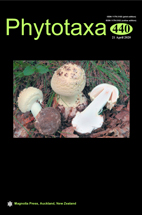Abstract
A new white-rot species, Phlebiopsis lacerata sp. nov., is proposed based on morphological and molecular characters. It is characterized by resupinate to effuse-reflexed basidiomata, a monomitic hyphal system with simple septate generative hyphae, conical cystidia that are thick-walled, heavily encrusted with large crystal in the apical part, and ellipsoid basidiospores (4–5.5 × 3–3.5 µm). Phylogenetic analyses of the ITS and LSU nrRNA gene regions showed that P. lacerata belongs to the Phanerochaetaceae and is nested in the phlebioid clade. Further investigation based on ITS+nLSU sequences with more representative taxa in Phlebiopsis demonstrated that P. lacerata forms a monophyletic lineage with a strong support (100% BS, 100% BP, 1.00 BPP) and then groups with P. crassa.

